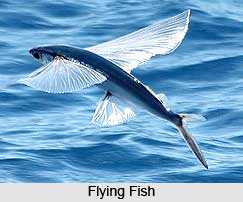 Flying Fish is a type of fish which during its normal swimming movement in water can occasionally take to aerial flight by jumping into the air and gliding horizontally. The distance thus covered is at times as long as four hundred metres. These fishes occur on both east and west coasts of India, but more on the south-west where they form a fishery in winter months. They belong to the family Exocoetidae. The species are recorded from Indian seas, of which three, Cypselurus altipennis, Exocoetus volitans, and Paraexocoetus brachypterus are common.
Flying Fish is a type of fish which during its normal swimming movement in water can occasionally take to aerial flight by jumping into the air and gliding horizontally. The distance thus covered is at times as long as four hundred metres. These fishes occur on both east and west coasts of India, but more on the south-west where they form a fishery in winter months. They belong to the family Exocoetidae. The species are recorded from Indian seas, of which three, Cypselurus altipennis, Exocoetus volitans, and Paraexocoetus brachypterus are common.
There are small twenty five centimetres long fish with elongated roundish body and long broad pectoral fins extending up to the tail fin, the lower lobe of which also is elongated and pronounced. In some species the pelvic fin too is enlarged. Being pelagic, they swim usually in the upper strata of water. When they are about to fly, they accelerate their speed for a short distance, then suddenly jerk their head out of water and with powerful vibrations of the caudal portion of their body and the tail fin kick the water surface and become air-borne like a plane, spreading out their large pectoral fins for gliding. The pectoral fins are not flapped like birds` or butterflies` wings but kept distended.
The aerial flights are undertaken usually to escape enemies or when alarmed by approaching ships. But sometimes they may be purposeful; probably to cover distances quickly while catching small pelagic fish for food.
Fishermen off the south-western coast of India tie a broad piece of cloth to two poles on a catamaran or a small boat while moving in the fishing area. The flying fish in their flight strike the cloth and fall into the boat, to be merely collected by the fishermen. The leaping action of fishes such as chanos, mullets and rohu across nets are merely to escape the nets and although they cover some distance in air, the action is different from flying or gliding. The eggs of flying fish have long tendril-like processes by which they are entangled with each other or attached to weeds. They remain floating till the young ones hatch out.



















